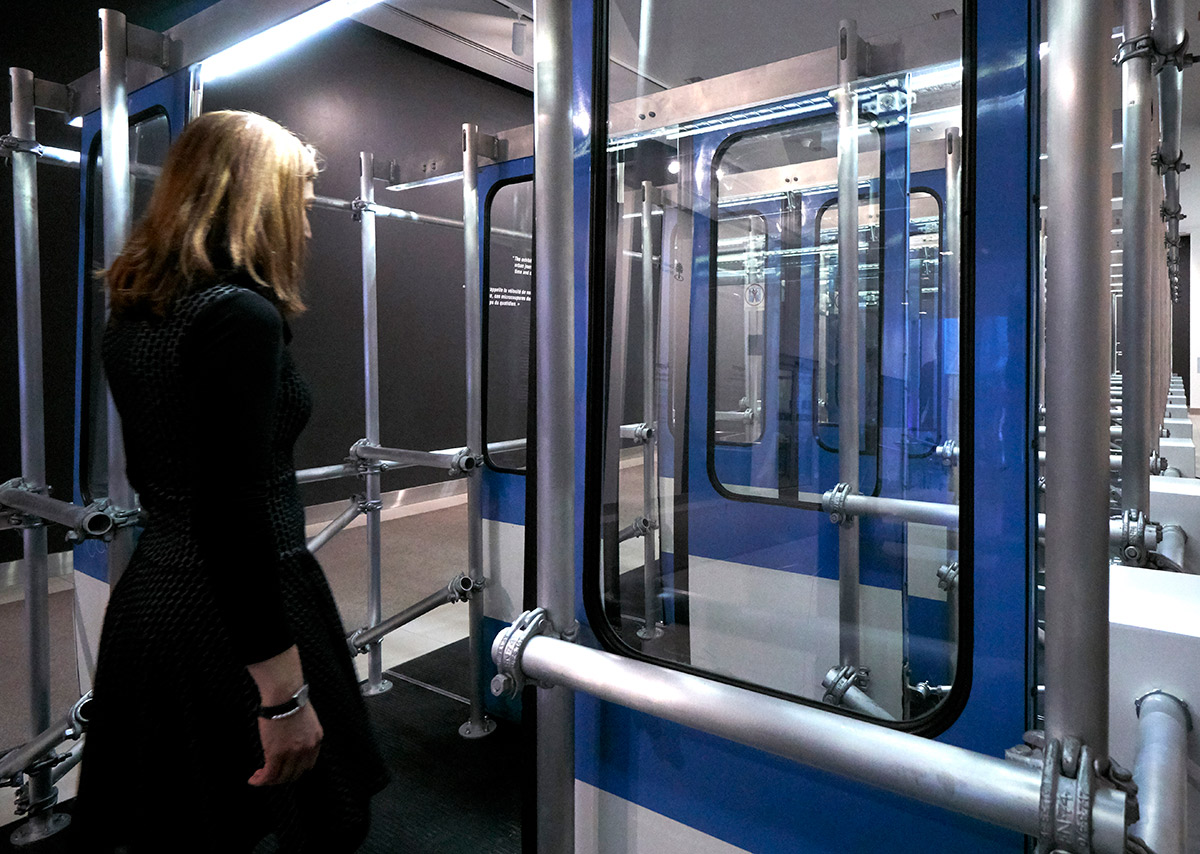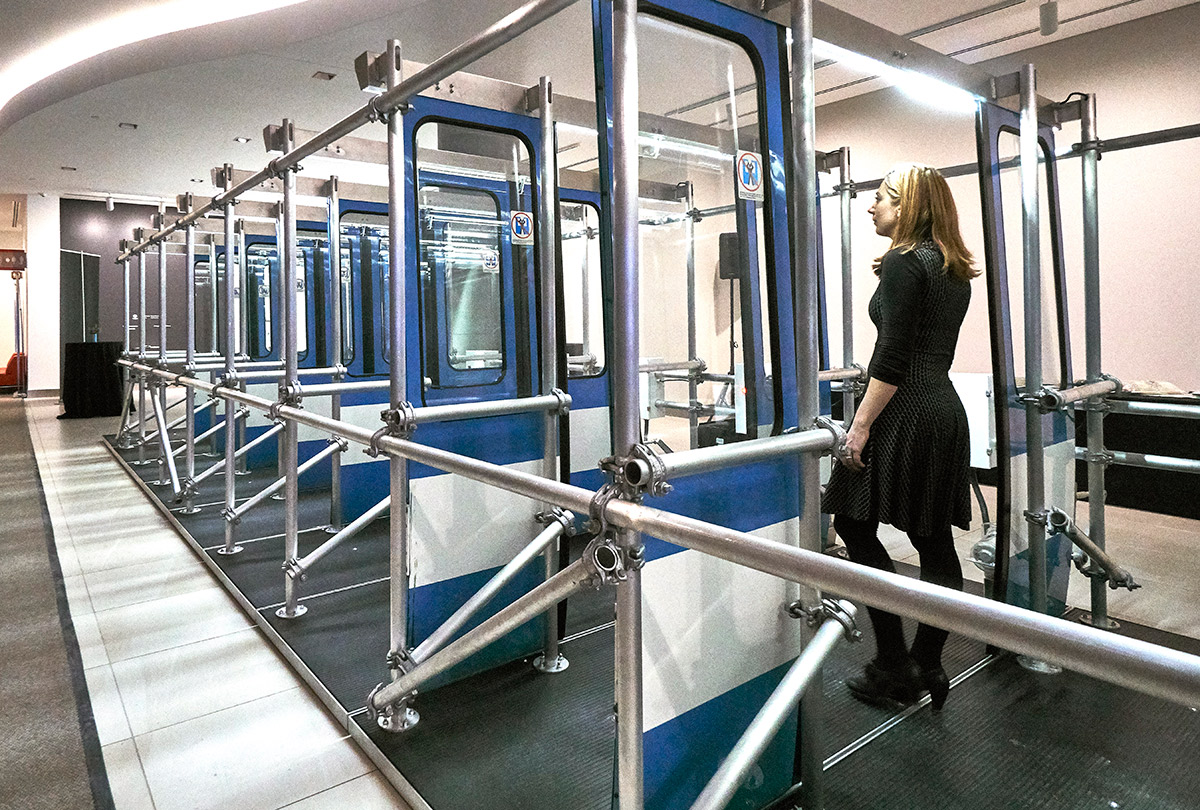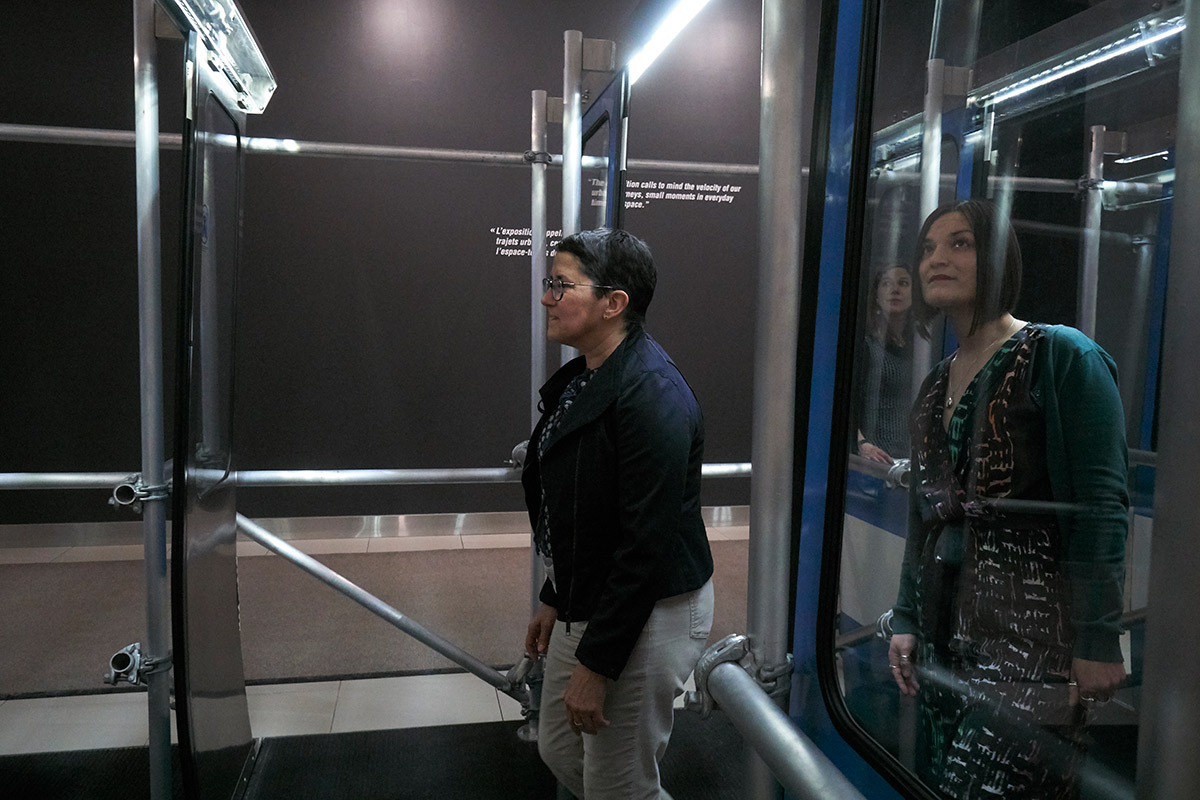
Canada Council presents
February 20 to June 9, 2019
Thresholds is an experience in transit. It calls to mind the velocity of our urban journeys, small moments in everyday time and space. The installation remakes the internal mechanics of door-opening devices found on old metro cars manufactured for the inauguration of the Montréal metro at the 1967 World Exhibition. The MR-63 car has now been replaced by more modern equipment, but its impact on the collective Montréal imagination is undeniable. Having survived the consumption cycle, the piece now serves to keep this technological memento alive. It is an investigation into possible worlds stemming from the relics of this one.
Thresholds
Whet your appetite for Michel de Broin’s Thresholds with this short video in which de Broin reveals the piece’s backstory and inner workings.
Come in for a visit and interact with the piece. Take a selfie and share it on social media using #Thresholds.
Curatorial Statement
Thresholds is an interactive installation that invites the general public to embark on a journey. It is a crossing that calls to mind the velocity of our urban journeys, small moments in everyday time and space.
Made up of a dozen metro car doors, the work activates in the presence of visitors. It literally holds the doors open for them as they approach and walk through it. The components come from old MR-63 metro cars, whose impact on the collective Montréal imagination is undeniable. The piece serves to keep this technological memento alive. The old cars were retired to a recycling centre, where they were ripped apart and recycled at great cost to the environment. In our consumerist society, technological objects become obsolete at an accelerated pace in a process that depreciates vestiges of the past. The technical development narrative contained in each progression is quickly undermined in disruptive chains of innovation. The parts that are reused after having been idle for some time still hold a treasure trove of, and tell a story about, human inventiveness. Dismantling obsolete mechanisms and giving them new life is fascinating because its dislocation updates human know-how and reveals where it was in terms of progress at a given time.
As visitors approach the installation, the first door opens and invites them inside. In a simultaneous sequence, the other doors give way and then close behind them to follow the movement of bodies through this transitory space. The successive mechanised opening and closing of the doors is synchronized thanks to sensors: anticipating the presence of a passenger, Thresholds sets off a fluid wave of movement triggered by an interactive system. It is a meeting and a convergence of two eras, that of integrated circuits governing the mechanical parts of a bygone one. The mechanism on each sliding door is showcased inside a Plexiglas box, so visitors can see it hard at work as they progress through the doors. Opting for transparency, the installation retains and remakes the internal mechanics of the original devices, highlighting them and reaffirming the innovation lying dormant at the heart of obsolescence.
Naked, on the threshold
Nathalie Bachand
 Nu (1998) par Michel de Broin
Nu (1998) par Michel de BroinA crossing of Thresholds, Michel de Broin’s interactive installation, extends beyond the last of the twelve automated MR-63 metro car doors. With the last door-opening device behind us, we are greeted by a photograph that we “enter.” A picture is also a space. We don’t enter it the same way we enter a physical location, but we enter it nonetheless. We see an environment, find certain points of reference—or not—assess boundaries and project ourselves into it.
Michel de Broin’s photograph, Nu (1998) [nude], which is presented in a very large illuminated box, was taken inside Montréal’s Crémazie metro station. Telltale characteristics, like the tiles in hues of maroon and beige, are easily recognizable. The ochre shapes, though, are what catch the eye—they interrogate and exalt the gaze. They are empty ad billboards, captured just before ads were installed. The picture shows an interim, a transitional moment in which time has stopped. It is also a time-space of potential that enables everyone—every viewer—to infer something that is theirs alone. In this case, the viewer arrives at the picture with a certain baggage: the experience of having walked through Thresholds or, at the very least, of its proximity, of having thought about interacting with it or watched someone else do so.
Thresholds and Nu coexisting in the exhibition space operates under a dynamic of adjacency: the works extend into each other; they share a liminary space where they can act on one another, back and forth. They interact through our gazes, through a sort of perceptive porosity, which means we cannot see the photograph without seeing the installation, and vice versa—like a superposition. The marked difference between the two mediums contributes to the permeability of the works: the two-dimensional aspect of the photograph gives the material, physical reality of the installation breadth. Conversely, the installation is embodied in the space of the photograph, extending it out of range, into a blind spot.
Created twenty years apart, Thresholds and Nu are works that echo each other across a hybrid temporality. The notion of transit, of movement and of the in-between that it represents is regularly found at the heart of Michel de Broin’s practice. Various works come to mind: Dendrites, 2017; Révolution, 2010; Shared Propulsion Car, 2005; Entrelacement, 2001; and the Silent Shouts (2008) photography series, which captured moments where passengers on public transportation are superimposed onto graffiti carved into the windows. Regardless of medium, these works propose spaces to inhabit. Each has its own unique way of letting viewers travel through them. They propose both implicit and explicit interactions. Where Thresholds is very tangible experience, with our steps opening the doors one by one, Nu, as a visual experience, is no less tangible—only, it travels through us differently.

About the artist
Michel de Broin deepens his cross-disciplinary practice by developing an ever-expanding visual vocabulary. His approach to production explores the intersections of technological, biological and physical systems. Crafting unexpected relationships between waste, productivity, consumption and risk, de Broin challenges the use value and conventional associations of familiar objects and symbols: he infuses them with new meaning and develops new contexts.
His work has been exhibited at the Musée d’art contemporain de Montréal; the Musée d’art contemporain du Val-de-Marne (France); the Künstlerhaus Bethanien (Berlin); the Plug In Institute of Contemporary Art (Winnipeg); the Museum Tinguely (Basel); Villa Arson (Nice); Eyebeam (New York City); and the Hessel Museum of Art (New York City). Several museums and public collections have acquired his work, including the National Gallery of Canada; the Art Gallery of Ontario; the Montreal Museum of Fine Arts; the Musée national des beaux-arts du Québec; the city of Montréal; the FRAC Poitou-Charentes (France); and the Neuer Berliner Kunstverein (Germany).
His public art works and commissions include Dendrites (Montréal, 2017); Thresholds (Montréal, 2017); Interlude (Québec City, 2016); Bloom (Calgary, 2015); Possibilities (Mississauga, 2012); Interlace (Changwong, 2012); Majestic (New Orleans, 2011); Revolution (Rennes, 2010); Arc (Montréal, 2009); La maîtresse de la Tour Eiffel (Paris, 2009); Overflow (Toronto, 2008); Encircling (Christchurch, 2006); Shared Propulsion Car (New York City, 2005; Toronto, 2007); Révolutions (Montréal, 2003).

About the Curator
Nathalie Bachand writes regularly on the visual and media arts.
She recently curated the group exhibition The Dead Web – La fin, presented at Eastern Bloc, and UN MILLION D’HORIZONS, a 32-exhibition project, for the Accès culture network as part of Montréal’s 375th anniversary celebrations, which took place in the summer of 2017.
She is currently the co-curator of the Espace [IM] Média festival at the Sporobole, centre en art actuel, for which she also writes essays on the relationship between art and science.








